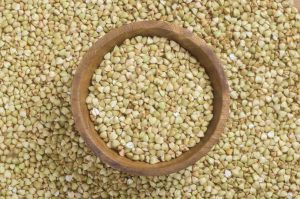Characteristics and Appeal of Soba Shochu
Soba shochu is a honkaku shochu made from buckwheat (soba) as its primary ingredient. First introduced in 1973, it is primarily produced in Miyazaki and Kagoshima Prefectures. Known for its nutty aroma and light, refreshing taste, soba shochu is a relatively new type of shochu but has already captivated many enthusiasts with its unique flavor.

(buckwheat grains)
1.Characteristics of the Ingredient
The main ingredient for soba shochu is domestically grown buckwheat. Buckwheat has long been cultivated in Japan, particularly in high-altitude mountainous areas. For shochu production, the seeds of the buckwheat plant are used. Buckwheat contains rutin, a compound responsible for its distinctive aroma, which is also a hallmark of soba shochu.
2.Major Production Areas
Takachiho, Miyazaki Prefecture
The Takachiho region in Miyazaki Prefecture is particularly renowned for soba shochu production. With its high altitude and climate ideal for buckwheat cultivation, the region is also blessed with pristine water resources, making it perfect for crafting high-quality soba shochu. The long-standing tradition of buckwheat farming in Takachiho has significantly influenced the techniques and culture of shochu production.

(Takachiho, Miyazaki Prefecture)
Kirishima mountain range, Kagoshima Prefecture
In Kagoshima, soba shochu is mainly produced around the Kirishima mountain range. The high-altitude region offers ideal conditions for buckwheat cultivation, and the volcanic soil contributes to the quality of water used in shochu production.

(Kirishima mountain range, Kagoshima Prefecture)
3.Unique Production Process
The production of soba shochu follows the same general process as other honkaku shochu, using rice koji for fermentation. White koji is the most commonly used, but some breweries opt for black or yellow koji, depending on the desired flavor profile. White koji tends to produce a refreshing aroma and a clean taste, while black koji yields a richer and deeper flavor.
4.Flavor Characteristics
Soba shochu is characterized by its nutty aroma and light, crisp taste. The aroma is reminiscent of roasted buckwheat flour, offering a subtle yet pleasant floral quality. Upon tasting, it delivers a refreshing and clean flavor, with a crisp finish that lingers lightly. Freshly distilled soba shochu has a pronounced fragrance, while aging mellows the flavor, adding depth and smoothness.
5.Impact of Distillation Methods
The choice of distillation method significantly influences the flavor of soba shochu:
Atmospheric Distillation: Retains the full aroma and flavor of buckwheat, producing a robust and flavorful profile.
Vacuum Distillation: Creates a softer, more elegant taste, appealing to those who prefer milder spirits.
Many breweries combine these techniques to craft balanced and distinctive products.
6.Importance of Water Quality
The pristine water of Takachiho and the Kirishima mountain range is essential to soba shochu production. These waters, enriched with balanced minerals, support fermentation and significantly influence the final flavor of the product.
7.Ways to Enjoy Soba Shochu
Soba shochu can be enjoyed in various ways that highlight its unique characteristics:
Watered Down (Mizuwari): Allows the natural aroma and flavor of buckwheat to shine, making it the most common serving style.
Hot Water Mix (Oyu-wari): Enhances the aroma and creates a smoother taste, perfect for colder seasons.
On the Rocks : Combines a refreshing chill with the delicate aroma of buckwheat.
8.Pairing with Food
Soba shochu pairs excellently with various dishes, particularly Japanese cuisine. Its light taste complements fish and vegetable dishes, enhancing their natural flavors. Its nutty aroma also makes it a versatile choice for pairing with a wide range of dishes, making it an excellent choice as a dining accompaniment.

(Unkai)
9.Modern Popularity
Soba shochu has recently gained popularity among younger drinkers and women. Its mild flavor and the familiarity of buckwheat as a traditional Japanese ingredient contribute to its appeal. Additionally, health-conscious consumers are drawn to the rutin and other beneficial compounds found in buckwheat.
10.Innovation and Sustainability
Soba shochu production continues to evolve. While preserving traditional methods, breweries are incorporating new technologies and insights to improve quality. Innovations include advanced temperature control and the development of new yeast strains. Sustainability is also a growing focus, with environmentally friendly practices being adopted in buckwheat cultivation and the production process.
11.Value as a Regional Industry
Soba shochu plays a vital role in the regional economy, particularly in the Takachiho area, where buckwheat farming and shochu production are key industries. It also serves as a tourist attraction, with brewery tours and tasting events contributing to regional revitalization.
12.Conclusion
Although a relatively new addition to the world of honkaku shochu, soba shochu has established a strong presence with its distinctive flavor and cultural significance. By leveraging the unique qualities of buckwheat and harmonizing with local nature and traditions, soba shochu offers a one-of-a-kind experience. As a result, it continues to be a beloved spirit, appealing to a growing audience both in Japan and beyond.



